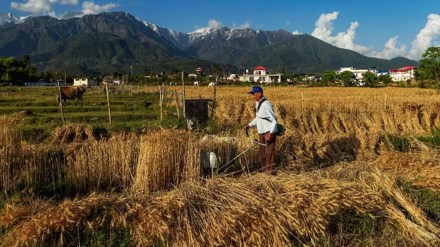The government on Wednesday announced annual hikes in the range of 2.4 -7% in the minimum support prices (MSP) for the winter-sown crops for the marketing season 2025-26 (April-June).
The MSP of wheat, the key rabi crop, has been raised by 6.6% to Rs 2,425/quintal for 2025-26 season, while in the previous year the remunerative price were hiked by 7.05%, the steepest rate ever, to Rs 2,275/quintal.
Officials said the hike in the MSP of wheat is significant as it is the second largest crop after paddy in terms of area under cultivation. In the 2023-24 crop year (July-June), the area under wheat was 31.83 million hectare (MH), while the production was estimated at a record 113.92 million tonnes (MT).
“Wheat prices are stable and there is no shortage as the country had a bumper output last year,” Food secretary Sanjeev Chopra recently stated. At present, FCI has 23.48 MT of wheat stock against the buffer of 20.52 MT for October 1.
In absolute terms, the highest increase in the MSP has been approved for mustard seed , which has a share of more than 40% in the country’s edible oil production, at Rs 300/quintal for next marketing season compared to current season.
MSP on mustard has been increased by 5.3% to Rs 5,990/quintal in the next marketing year from Rs 5,650/quintal in 2024-25 marketing season and the aim is to encourage farmers to grow more oilseeds so that import dependence on edible oil could be reduced.
“The increase in MSP of rabi crops will ensure remunerative prices to the farmers and incentivise crop diversification,” according to an official statement.
Madan Sabnavis, chief economist, Bank of Baroda said the overall inflationary impact on hike in MSP would be lower at 0.18-0.20% over year. The increase in MSP varies from 2.4% for safflower to 7% for barley for next marketing season.
The MSP for gram has been increased by 3.9% to Rs 5,650/quintal, from the current MSP of Rs 5,440/quintal.
Gram has around 50% share in the country’s pulses output and biggest pulse crop in terms of area. In 2023-24, the area under gram was recorded at 9.5 MH, while the output in 2023-24 crop year was at 11.03 MT.
From 2018-19, a new policy of 50% profits over computed cost of production was adopted which resulted in MSP hikes for rabi crops in the range of 5-7.6%.
“The expected margin over All-India weighted average cost of production is 105% for wheat, mustard (98%), lentil ( 89%), gram (60%), barley (60%) and safflower (50%) ,” according to an official statement.
“The MSP for oilseeds and pulses has been hiked substantially in the last few years to encourage higher production, the real issue is the need to increase productivity of these crops through better seeds and farm practices,” an official told FE.
Information and broadcasting minister Ashwini Vaishnaw said that during 2014-2024, the government agencies had paid Rs 20.64 lakh crore for procurement of various crops at MSP while in the previous decades the volume of MSP purchase was Rs 7.41 lakh crore.
The government fixes MSP following the reports of the Commission for Agricultural Costs and Prices (CACP), which recommends the MSPs for around 23 crops to the government.
Rabi crops are sown during October and November and the produce is harvested from February depending on the maturity period of the crop.
